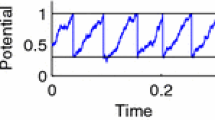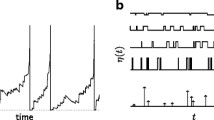Abstract
We consider a pair of stochastic integrate and fire neurons receiving correlated stochastic inputs. The evolution of this system can be described by the corresponding Fokker–Planck equation with non-trivial boundary conditions resulting from the refractory period and firing threshold. We propose a finite volume method that is orders of magnitude faster than the Monte Carlo methods traditionally used to model such systems. The resulting numerical approximations are proved to be accurate, nonnegative and integrate to 1. We also approximate the transient evolution of the system using an Ornstein–Uhlenbeck process, and use the result to examine the properties of the joint output of cell pairs. The results suggests that the joint output of a cell pair is most sensitive to changes in input variance, and less sensitive to changes in input mean and correlation.
Similar content being viewed by others
References
Badel L, Gerstner W, Richardson M (2010) Transition-state theory for integrate-and-fire neurons. Computational and Systems Neuroscience, Salt Lake City
Bourgeat A, Kern M (2004) Simulation of transport around a nuclear waste disposal site: the couplex test cases Computational Geosciences (special issue). Springer, Berlin
Bruneau CH, Marpeau F, Saad M (2005) Numerical simulation of the miscible displacement of radionuclides in a heterogeneous porous medium. Int J Numer Meth Fluids 49: 1053–1085
Brunel N, Latham PE (2003) Firing rate of the noisy quadratic integrate-and-fire neuron. Neural Comput 15: 2281–2306
Burak Y, Lewallen S, Sompolinsky H (2009) Stimulus-dependent correlations in threshold-crossing spiking neurons. Neural Comput 21(8): 2269–2308
Burkitt AN (2006) A review of the integrate-and-fire neuron model: I. Homogeneous synaptic input. Biol Cybern 95: 1–19
Burkitt AN (2006) A review of the integrate-and-fire neuron model: II. Inhomogeneous synaptic input and network properties. Biol Cybern 95: 97–112
Courant R, Friedrichs K, Lewy H (1928) Uber die partiellen Differenzengleichungen der mathematischen Physik. Math Ann 100: 32–74
de la Rocha J, Doiron B, Shea-Brown E, Josić K, Reyes A (2007) Correlation between neural spike trains increases with firing rate. Nature 448: 802–806
Ermentrout GB, Kopell N (1986) Parabolic bursting in an excitable system coupled with a slow oscillation. SIAM J Appl Math 46: 233–253
Faisal AA, Selen LPJ, Wolpert DM (2008) Noise in the nervous system. Nat Rev Neurosci 9(4): 292–303
Galán RF, Ermentrout GB, Urban NN (2007) Stochastic dynamics of uncoupled neural oscillators: Fokker–Planck studies with the finite element method. Phys Rev E 76(5): 56110
Gardiner CW (1985) Handbook of stochastic methods. Springer, New York
Godlewski E, Raviart PA (1990) Hyperbolic systems of conservation laws. In: Mathématiques et applications. Ellipses
Harrison LM, David O, Friston KJ (2005) Stochastic models of neuronal dynamics. Philos Trans R Soc B 360: 1075–1091
Hasegawa H (2009) Population rate codes carried by mean, fluctuation and synchrony of neuronal firings. Phys A 388: 499–513
Iannelli M (1994) Mathematical theory of age-structured population dynamics. Math Monogr, C.N.R. Pisa
Keener J, Sneyd J (2008) Mathematical physiology. Springer, Berlin
Khorsand P, Chance F (2008) Transient responses to rapid changes in mean and variance in spiking models. PLoS ONE 3: 1757
Kloeden PE, Platen E (1992) Numerical solution of stochastic differential equations. Springer, New York
Knight BW (1972) Dynamics of encoding in a population of neurons. J Gen Physiol 56: 734–766
Lindner B (2001) Coherence and stochastic resonance in nonlinear dynamical systems. Humboldt University, California
Ly C, Tranchina D (2009) Spike train statistics and dynamics with synaptic input from any renewal process: a population density approach. Neural Comput 21: 360–396
Marpeau F, Barua A, Josić K (2009) A finite volume method for stochastic integrate-and-fire models. J Comput Neurosci 26: 445–457
Marpeau F, Saad M (2010) 3D simulation of radionuclide transport in porous media. Int J Numer Methods Fluids 64(1): 44–70
Masuda N (2006) Simultaneous rate-synchrony codes in populations of spiking neurons. Neural Comput 18: 45–59
Meda I, Atwater I, Bangham A, Orci L, Rojas E (1984) The topography of electrical synchrony among β-cells in the mouse islet of Langerhans. Q J Exp Physiol 69: 719–735
Melnikov V (1993) Schmitt trigger: a solvable model of stochastic resonance. Phys Rev E 48: 2481–2489
Moreno-Bote R, Parga N (2006) Auto-and crosscorrelograms for the spike response of leaky integrate- and-fire neurons with slow synapses. Phys Rev L 96(2): 28101
Moreno-Bote R, Parga N (2010) Response of integrate-and-fire neurons to noisy inputs filtered by synapses with arbitrary timescales: firing rate and correlations. Neural Comp 22: 1528–1572
Nykamp DQ, Tranchina D (2000) A population density approach that facilitates large-scale modeling of neural networks: analysis and an application to orientation tuning. J Comp Neurosci 8: 19–50
Omurtag A, Knight B, Sirovich L (2000) On the simulation of large populations of neurons. J Comp Neurosci 8(1): 51–63
Ostojić S, Brunel N, Hakim V (2009) How connectivity, background activity, and synaptic properties shape the cross-correlation between spike trains. J Neurosci 29(33): 10234–10253
Rasetarinera P (1995) Étude mathématique et numérique de la restauration biologique en milieux poreux. University Bordeaux 1, Talence
Renart A, Song P, Wang X-J (2003) Robust spatial working memory through homeostatic synaptic scaling in heterogeneous cortical networks. Neuron 38(473): 473–485
Richardson MJE (2007) Firing-rate response of linear and nonlinear integrate-and-fire neurons to modulated current-based and conductance-based synaptic drive. Phys Rev E 76(2): 21919
Ringach DL, Malone BJ (2007) The operating point of the cortex: neurons as large deviation detectors. J Neurosci 27: 7673–7683
Rolls ET, Loh M, Deco G, Winterer Malone G (2008) Computational models of schizophrenia and dopamine modulation in the prefrontal cortex. PLoS Comput Biol 9: 696–708
Rosenbaum R, Trousdale J, Josić K (2010) Pooling and correlated neural activity. Front Comput Neurosci 4(9):1–14
Rosenbaum R, Josić K (2011) Mechanisms that modulate the transfer of spiking correlations. Neural Comput 23(5): 1261–1305
Salinas E, Sejnowski T (2000) Impact of correlated synaptic input on output firing rate and variability in simple neuronal models. J Neurosci 20(16): 6193–6209
Schneider A, Lewis T, Rinzel J (2006) Effects of correlated input and electrical coupling on synchrony in fast-spiking cell networks. Neurocomputing 69: 1125–1129
Shadlen M, Newsome W (1998) The variable discharge of cortical neurons: implications for connectivity, computation, and information coding. J Neurosci 18(10): 3870–3896
Shea-Brown E, Josić K, de la Rocha J, Doiron B (2008) Correlation and synchrony transfer in integrate-and-fire neurons: basic properties and consequences for coding. Phys Rev Lett 100: 108102
Sherman A, Rinzel J (1991) Model for synchronization of pancreatic β-cells by gap junctions. Biophys J 59: 547–559
Silberberg G, Bethge M, Markram H, Pawelzik K, Tsodyks M (2004) Dynamics of population rate codes in ensembles of neocortical neurons. J Neurophys 91: 704–709
Sirovich L (2008) Populations of tightly coupled neurons: the RGC/LGN system. Neural Comput 20: 1179–1210
Sompolinsky H, Yoon H, Kang K, Shamir M (2001) Population coding in neuronal systems with correlated noise. Phys Rev E 64(5): 051904
Tchumatchenko T, Malyshev A, Geisel T, Volgushev M, Wolf F (2010) Correlations and synchrony in threshold neuron models. Phys Rev Lett 104: 5
Tuckwell HC (1988) Introduction to theoretic neurobiology, vol 2. Cambridge University Press, Cambridge
van Kampen N (2007) Stochastic processes in physics and chemistry. North-Holland, Amsterdam
Vilela R, Lindner B (2009) Comparative study of different integrate-and-fire neurons: spontaneous activity, dynamical response, and stimulus-induced correlation. Phys Rev E 80: 031909
Webb G (1985) Theory of nonlinear age-dependent population dynamics. Maecel Dekker, New York
Author information
Authors and Affiliations
Corresponding author
Additional information
R. Rosenbaum and F. Marpeau contributed equally to this work.
Rights and permissions
About this article
Cite this article
Rosenbaum, R., Marpeau, F., Ma, J. et al. Finite volume and asymptotic methods for stochastic neuron models with correlated inputs. J. Math. Biol. 65, 1–34 (2012). https://doi.org/10.1007/s00285-011-0451-3
Received:
Revised:
Published:
Issue Date:
DOI: https://doi.org/10.1007/s00285-011-0451-3




